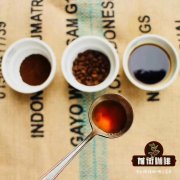Kenyan Andabeth Manor Solar Micro batch | introduction to the flavor and taste of Kenyan coffee varieties

Professional coffee knowledge exchange more coffee bean information please follow the coffee workshop (Wechat official account cafe_style)
Washed Kenyan coffee has bright and lively acidity, refreshing taste, sun-treated Kenyan coffee fruit with obvious notes, high sweetness and thick taste. Today, the editor will introduce to you the micro-batch of beans produced in the eastern rift valley [Andabes Manor, Kenya].
Introduction of manors in producing areas
The East African Rift Valley (Great Rift Valley), located in eastern Africa, is a geographical spectacle formed by the crustal movement of the African plate 35 million years ago. The Great Rift Valley, which runs through East Africa, is the largest fault zone in the world and belongs to the growth boundary.
The eastern part of the Rift Valley in Kenya is the deeper part of the entire East African Rift Valley, the deepest of which is north of Nairobi, Kenya, where the rift valley does not go to sea, so the resulting lakes are shallow and contain more minerals and salts. Lake Magadi, for example, is almost entirely composed of sodium carbonate. Lake Elmenteta (Lake Elmenteita), Lake Balingo, Lake Bergolia and Lake Nakuru (Lake Nakuru) are quite alkaline.
The rift contains Mount Cherang'any and a series of volcanoes, some of which are still active. Cherang'any Hills is one of Kenya's five largest forests and catchment areas, spanning three counties, namely Trans Nzoia,Elgeyo Marakwet and West Pokot. Endebess Estate Farm is located at the foot of Mount Elgon Mountain, an extinct volcano on the border between Uganda and Kenya.
As early as the 1940s, Endebess Estate developed and processed its own coffee and nearby small producers. It was once owned and managed by Mr. EW Dempsey 39 Ollier and sold to Gatatha Farmers Co Ltd in 1976 and re-sold to its current owner and manager Kaitet Tea Plantations in 2011.
Kate Plantation focuses on employee welfare and social responsibility. The farm has funded 15 housing renovation projects, sponsored two high school students, and hopes that their social responsibility programs will be expanded once the farm makes more profits. In the short term, Endebess Estate is improving the certification status of its infrastructure.
Andabeth Manor is located next to Mountain Elgon, near the city of Kitale Town. The size of the estate is about 758 hectares, of which 248 hectares are grown coffee. The surrounding coffee harvest is about 1750-1950 meters above sea level, with an average annual rainfall of about 1000 mm, and the soil is quite fertile volcanic soil. Kenya has always been famous for producing high-quality washed coffee. Because of its unique environment, culture, and variety, Kenya has customized this version of suntan Kenya. At the beginning of the season, he visited the local area directly and calibrated the cup to test the flavor. After many sample exchanges, the flavor of this batch was finally determined.
It has a strong fruity aroma and high sweetness. The history of the manor dates back to the 1940s, when it was owned by the family of Mr. EW Dacheng 39th Olloer, who handled not only his own coffee but also the surrounding small farmers. In 1976, the family sold the estate to Gatatha Farmers Co Ltd and did not transfer the management to its current owner, Kaitet Tea Plantations Ltd, until September 2011. Kaitet Tea Plantations Ltd has always attached great importance to the welfare of its employees, and the surrounding communities will build dormitories for employees and support local poor students to go to school.
Introduction of variety, flavor and taste
The two varieties were first commissioned by the Kenyan government in the 1930s, and the varieties suitable for the country were selected by Scott Labs. After numbering and screening one by one, SL-28 and SL-34 were finally obtained, both of which originated from bourbon, and SL-34 can grow in areas with lower elevations.
SL28 has a mixed pedigree of French missionaries, mochas and Yemeni iron pickups. The goal of cultivating SL28 was to mass produce coffee beans with high quality and resistance to diseases and insect pests.
Although the yield of SL28 was not as high as expected the copper leaf color and broad bean-shaped beans have great sweetness balance and complex flavor as well as significant citrus and black plum characteristics.
SL34 is similar to SL28 in flavor, with a heavier, fuller and cleaner finish than SL28, except for its complex acidity and great sweetness. SL34 has French missionaries, bourbon, and more Ironka lineage. Dou looks similar to SL28, but is more adaptable to sudden heavy rain.
END
Important Notice :
前街咖啡 FrontStreet Coffee has moved to new addredd:
FrontStreet Coffee Address: 315,Donghua East Road,GuangZhou
Tel:020 38364473
- Prev

The birth of Pacamara and its characteristics how is the flavor of Pacamara
For more information on coffee beans, please follow the Coffee Workshop (Wechat official account cafe_style) Pacamara, a new hybrid born in El Salvador in 1958, but it was not until the 21st century that it was grown slightly more. When Robin filmed a coffee documentary in Melbourne in 2014, it was still a legendary rare bean species, and many people only knew its name but never tasted it.
- Next

Characteristics of sunny West Coach Coffee in Costa Rica Manor introduction to the varieties of Ethiopian West Koch
For more information on coffee beans, please follow the Coffee Workshop (Wechat official account cafe_style). In the 1950s, in Gemma, a small town in western Ethiopia, West Kokoch found that compared with other rose summers in Ethiopia, Abyssinia is very different, and this variety has more red fruit flavor and sweetness.
Related
- Does Rose Summer choose Blue, Green or Red? Detailed explanation of Rose Summer Coffee plots and Classification in Panamanian Jade Manor
- What is the difference between the origin, producing area, processing plant, cooperative and manor of coffee beans?
- How fine does the espresso powder fit? how to grind the espresso?
- Sca coffee roasting degree color card coffee roasting degree 8 roasting color values what do you mean?
- The practice of lattes: how to make lattes at home
- Introduction to Indonesian Fine Coffee beans-- Java Coffee producing area of Indonesian Arabica Coffee
- How much will the flavor of light and medium roasted rose summer be expressed? What baking level is rose summer suitable for?
- Introduction to the characteristics of washing, sun-drying or wet-planing coffee commonly used in Mantenin, Indonesia
- Price characteristics of Arabica Coffee Bean Starbucks introduction to Manning Coffee Bean Taste producing area Variety Manor
- What is the authentic Yega flavor? What are the flavor characteristics of the really excellent Yejasuffi coffee beans?

